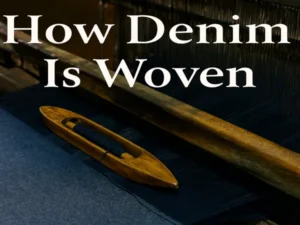Sewing jeans fabric can be a rewarding endeavor, allowing you to create custom-fit garments that showcase your style. However, achieving professional-looking results requires meticulous attention to detail, particularly when it comes to tension settings on your sewing machine.
In this guide, we will delve into the intricacies of tension:
- Understanding its role in sewing machines.
- Factors to consider when choosing tension for different jean fabrics.
- How to determine the initial tension?
- What tension should you use when sewing a pair of jeans?
- Troubleshooting common tension issues?
- Tips for achieving a balanced stitch.
Understanding Tension in Sewing Machines
In sewing, tension refers to the amount of resistance applied to the thread as it passes through the machine. It plays a crucial role in creating balanced and secure stitches, ensuring the integrity and durability of your sewn garments.
- Definition and Role of Tension
A well-adjusted tension setting results in neat, evenly-spaced stitches on both sides of the fabric. However, improper tension can lead to various issues like puckering stitches, loose and loopy stitches, or even broken threads.
Factors to Consider When Choosing Tension for Jeans Fabric
To master the art of sewing jeans, it is essential to understand the factors that influence tension selection.
- Type of Jeans Fabric
Firstly, the type of jeans fabric you’re working with plays a significant role. Different denim weaves, such as lightweight, medium-weight, or heavyweight, require varying tension settings for optimal results.

- Thickness and Weight
Secondly, the thickness and weight of the denim fabric also influence tension, as thicker fabrics generally require higher tension settings.
- Needle Size and Type
Lastly, needle size and type affect tension as well, with larger needles often requiring adjustments to achieve balanced stitches.
How to Determine the Initial Tension for Jeans Fabric?
- Testing on Scrap Fabric
Before diving into sewing your prized jeans, it is prudent to determine the initial tension setting on scrap denim fabric.
- Adjusting Gradually
By selecting a representative piece of fabric and stitching a sample seam, you can observe the resulting stitches and make necessary adjustments. Begin with a slightly higher tension than what you would use for lightweight fabrics and gradually fine-tune until you achieve a balanced stitch.
What Tension Should You Use When Sewing a Pair of Jeans?
Do you know what tension you should use when sewing jeans?
After research, we need recommended tension settings for different denim materials, as follows:
Understanding the recommended tension settings for different jean materials is key to achieving professional results.

- LightweightDenim
A tension setting between 2.5 and 3 on your machine is generally suitable for lightweight denim.
- Medium-weight denim
Medium-weight denim typically requires a tension setting between 3 and 4.
- Heavyweight Denim
Heavyweight denim may need a higher tension between 4 and 5.
These recommended settings serve as starting points, and you may need to make slight adjustments based on your specific machine and fabric combination.
Troubleshooting Common Tension Issues
While striving for perfect tension, various issues may arise.
- Puckering Stitches
Puckering stitches can occur when tension is set too tight, causing the fabric to gather.
- Loose or Loopy Stitches
Conversely, loose or loopy stitches are indicative of tension that is too loose.
- Broken Threads
Broken threads can stem from incorrect tension or other factors, such as using the wrong needle size.
By identifying these common tension-related problems, you can troubleshoot them effectively and enhance the quality of your seams.
Tips for Achieving a Balanced Stitch
Achieving balanced stitches in your jeans sewing project relies on tension settings and the following tips.
- Regular Maintenance of Sewing Machines
Regular maintenance of your sewing machine, including cleaning and oiling, facilitates smooth operation, reducing the likelihood of tension-related issues.
- Using Quality Thread
Using high-quality thread ensures its compatibility with the fabric and promotes better tension control.
- Proper Needle Selection
Additionally, selecting the appropriate needle for the denim fabric’s weight and type is crucial to achieving balanced stitches and preventing skipped stitches or fabric damage.
Conclusion
Achieving Professional Results with the Right Tension
Mastering the art of sewing jeans requires attention to detail, particularly in selecting the right tension. By understanding the definition and role of tension, considering factors such as fabric type, weight, and needle selection, and fine-tuning tension settings through testing and gradual adjustments, you can create professional-looking jeans that fit perfectly. Troubleshooting common tension issues and following maintenance tips further enhance the quality of your finished garments.
With practice, patience, and the guidance provided in this comprehensive guide, you will confidently embark on your journey to sewing jeans with exceptional craftsmanship.





